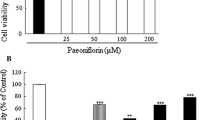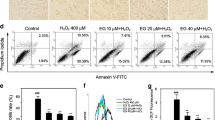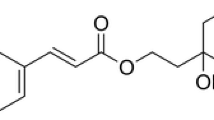Abstract
The neurotoxicity of fluoride is associated with oxidative stress due to imbalance between production and removal of reactive oxygen species (ROS). In contrast, induction of detoxifying and antioxidant genes through activation of NF-E2-related factor 2 (Nrf2) has been implicated in preventing oxidative stress and apoptosis in neurodegenerative diseases. The present study aimed to investigate the possible neuroprotective role of tert-butylhydroquinone (tBHQ), a general Nrf2 activator, on sodium fluoride (NaF)-induced oxidation damage and apoptosis in neuron-like rat pheochromocytoma (PC12) cells. Pretreatment with tBHQ protected PC12 cells against NaF-induced cytotoxicity as measured by MTT assay and apoptosis detection, simultaneously, inhibited NaF-induced overproduction of intracellular ROS and reduction of total glutathione content. Furthermore, NaF or tBHQ induced the stabilization of Nrf2, and enhanced expression of heme oxygenase-1 (HO-1) and γ-glutamylcysteine synthetase (γ-GCS) as a consequence of Nrf2 inducing. These findings indicated that tBHQ pretreatment conferred protective effect on PC12 cells against NaF-induced apoptotic cell death and oxidation-redox imbalance through stabilization of Nrf2 and elevation of downstream HO-1 and γ-GCS expressions.





Similar content being viewed by others
References
Akhter H, Katre A, Li L, Liu X, Liu RM (2011) Therapeutic potential and anti-amyloidosis mechanisms of tert-butylhydroquinone for Alzheimer’s disease. J Alzheimer’s Dis 26:767–778
Atmaca N, Atmaca HT, Kanici A et al (2014) Protective effect of resveratrol on sodium fluoride-induced oxidative stress, hepatotoxicity and neurotoxicity in rats. Food Chem Toxicol 70:191–197
Barbier O, Arreola-Mendoza L, Del Razo LM (2010) Molecular mechanisms of fluoride toxicity. Chem Biol Interact 188(2):319–333
Basha PM, Madhusudhan N (2010) Pre and post natal exposure of fluoride induced oxidative macromolecular alterations in developing central nervous system of rat and amelioration by antioxidants. Neurochem Res 35(7):1017–1028
Basha PM, Rai P, Begum S (2011) Evaluation of fluoride-induced oxidative stress in rat brain: a multigeneration study. Biol Trace Elem Res 142(3):623–637
Bharti VK, Srivastava RS (2009) Fluoride-induced oxidative stress in rat’s brain and its amelioration by buffalo (Bubalus bubalis) pineal proteins and melatonin. Biol Trace Elem Res 130(2):131–140
Calkins MJ, Johnson DA, Townsend JA et al (2009) The Nrf2/ARE pathway as a potential therapeutic target in neurodegenerative disease. Antioxid Redox Signal 11(3):497–508
Choi AL, Sun G, Zhang Y et al (2012) Developmental fluoride neurotoxicity: a systematic review and meta-analysis. Environ Health Perspect 120(10):1362–1368
Gan L, Johnson JA (2014) Oxidative damage and the Nrf2-ARE pathway in neurodegenerative diseases. Biochim Biophys Acta 1842(8):1208–1218
Greene LA, Tischler AS (1976) Establishment of a noradrenergic clonal line of rat adrenal pheochromocytoma cells which respond to nerve growth factor. Proc Natl Acad Sci USA 73:2424–2428
Gui C-Z, Ran L-Y, Li J-P et al (2010) Changes of learning and memory ability and brain nicotinic receptors of rat offspring with coal burning fluorosis. Neurotoxicol Teratol 32(5):536–541
Hybertson BM, Gao B (2014) Role of the Nrf2 signaling system in health and disease. Clin Genet 86(5):447–452
Jiang GZ, Li JC (2014) Protective effects of ginsenoside Rg1 against colistin sulfate-induced neurotoxicity in PC12 cells. Cell Mol Neurobiol 34:167–172
Jiang C, Zhang S, Liu H et al (2013) Low Glucose Utilization and Neurodegenerative Changes Caused by Sodium Fluoride Exposure in Rat’s Developmental Brain. Neuromolecular Med. doi:10.1007/s12017-013-8260-z
Jin X, Liu Q, Jia L et al (2014) Pinocembrin Attenuates 6-OHDA-induced Neuronal Cell Death Through Nrf2/ARE Pathway in SH-SY5Y Cells. Cell Mol Neurobiol. doi:10.1007/s10571-014-0128-8
Johnson JA, Johnson DA, Kraft AD et al (2008) The Nrf2-ARE pathway: an indicator and modulator of oxidative stress in neurodegeneration. Ann N Y Acad Sci 1147:61–69
Joshi G, Johnson JA (2012) The Nrf2-ARE pathway: a valuable therapeutic target for the treatment of neurodegenerative diseases. Recent Pat CNS Drug Discov 7(3):218–229
Jothiramajayam M, Sinha S, Ghosh M et al (2014) Sodium fluoride promotes apoptosis by generation of reactive oxygen species in human lymphocytes. J Toxicol Environ Health A 77(21):1269–1280
Khodagholi F, Tusi SK (2011) Stabilization of Nrf2 by tBHQ prevents LPS-induced apoptosis in differentiated PC12 cells. Mol Cell Biochem 354(1–2):97–112
Li J, Johnson D, Calkins M et al (2005) Stabilization of Nrf2 by tBHQ confers protection against oxidative stress-induced cell death in human neural stem cells. Toxicol Sci 83(2):313–328
Li H, Wu S, Shi N et al (2011) NF-E2-related factor 2 activation in PC12 cells: its protective role in manganese-induced damage. Arch Toxicol 85(8):901–910
Li H, Wu S, Wang Z et al (2012) Neuroprotective effects of tert-butylhydroquinone on paraquat-induced dopaminergic cell degeneration in C57BL/6 mice and in PC12 cells. Arch Toxicol 86(11):1729–1740
Liu F, Ma J, Zhang H et al (2014) Fluoride exposure during development affects both cognition and emotion in mice. Physiol Behav 124:1–7
Lou H, Jing X, Ren D et al (2012) Eriodictyol protects against H(2)O(2)-induced neuron-like PC12 cell death through activation of Nrf2/ARE signaling pathway. Neurochem Int 61(2):251–257
Miao K, Zhang L, Yang S et al (2013) Intervention of selenium on apoptosis and Fas/FasL expressions in the liver of fluoride-exposed rats. Environ Toxicol Pharmacol 36(3):913–920
Nabavi SF, Nabavi SM, Habtemariam S et al (2013) Neuroprotective effects of methyl-3-O-methyl gallate against sodium fluoride-induced oxidative stress in the brain of rats. Cell Mol Neurobiol 33(2):261–267
Nguyen Ngoc TD, Son YO, Lim SS et al (2012) Sodium fluoride induces apoptosis in mouse embryonic stem cells through ROS-dependent and caspase- and JNK-mediated pathways. Toxicol Appl Pharmacol 259(3):329–337
Nouhi F, Tusi SK, Abdi A et al (2011) Dietary supplementation with tBHQ, an Nrf2 stabilizer molecule, confers neuroprotection against apoptosis in amyloid beta-injected rat. Neurochem Res 36(5):870–878
Pereira M, Dombrowski PA, Losso EM et al (2011) Memory impairment induced by sodium fluoride is associated with changes in brain monoamine levels. Neurotox Res 19(1):55–62
Saxena S, Sahay A, Goel P (2012) Effect of fluoride exposure on the intelligence of school children in Madhya Pradesh. India. J Neurosci Rural Pract 3(2):144–149
Song GH, Gao JP, Wang CF et al (2014) Sodium fluoride induces apoptosis in the kidney of rats through caspase-mediated pathways and DNA damage. J Physiol Biochem 70(3):857–868
Thanan R, Oikawa S, Hiraku Y et al (2014) Oxidative Stress and Its Significant Roles in Neurodegenerative Diseases and Cancer. Int J Mol Sci 16(1):193–217
Wang Z, Yang X, Yang S et al (2011) Sodium fluoride suppress proliferation and induce apoptosis through decreased insulin-like growth factor-I expression and oxidative stress in primary cultured mouse osteoblasts. Arch Toxicol 85(11):1407–1417
Wang Q, Cui KP, Xu YY et al (2013) Coal-burning endemic fluorosis is associated with reduced activity in antioxidative enzymes and Cu/Zn-SOD gene expression. Environ Geochem Health. doi:10.1007/s10653-013-9522-2
Wu J, Yang J, Liu Q et al (2013) Lanthanum induced primary neuronal apoptosis through mitochondrial dysfunction modulated by Ca(2)(+) and Bcl-2 family. Biol Trace Elem Res 152(1):125–134
Xu Z, Xu B, Xia T et al (2013) Relationship between intracellular Ca(2)(+) and ROS during fluoride-induced injury in SH-SY5Y cells. Environ Toxicol 28(6):307–312
Zhang M, Wang A, He W et al (2007) Effects of fluoride on the expression of NCAM, oxidative stress, and apoptosis in primary cultured hippocampal neurons. Toxicology 236(3):208–216
Zhang S, Zhang X, Liu H et al (2015) Modifying effect of COMT gene polymorphism and a predictive role for proteomics analysis in children’s intelligence in endemic fluorosis area in Tianjin, China. Toxicol Sci. doi:10.1093/toxsci/kfu311
Conflict of interest
The authors declare that there are no conflict of interest.
Author information
Authors and Affiliations
Corresponding author
Rights and permissions
About this article
Cite this article
Wu, J., Cheng, M., Liu, Q. et al. Protective Role of tert-Butylhydroquinone Against Sodium Fluoride-Induced Oxidative Stress and Apoptosis in PC12 Cells. Cell Mol Neurobiol 35, 1017–1025 (2015). https://doi.org/10.1007/s10571-015-0196-4
Received:
Accepted:
Published:
Issue Date:
DOI: https://doi.org/10.1007/s10571-015-0196-4




